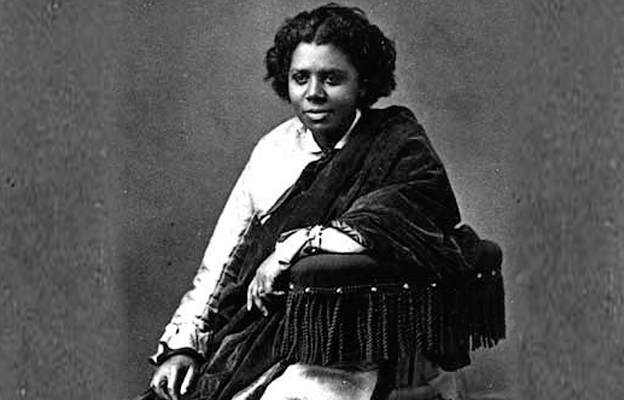Mary Edmonia Lewis was born free in New York and became the first African American and Native American ancestry to attain fame as an internationally recognized sculptor in the fine arts world.
Lewis had little training yet she overcame numerous obstacles to become a respected artist in history redefining the 19th-century definition of sculpting.
Born around 1844 in upstate New York to a black father and part-Ojibwa mother, Lewis became orphaned at an early age and, as her biography claimed, she was raised by her mother’s relatives.
She attended Oberlin College in Ohio where her life almost came to a disastrous halt when she was falsely accused of poisoning two white classmates.
She was kidnapped, beaten by a white mob and left to die. The strong-willed battered Lewis, who was already a talented artist struggled to recover from serious injuries.

When she was acquitted of the charges leveled against her, she moved to Boston, Massachusetts.
The audacious Lewis did not want to be anything other than to be an artist at the time when it sounded impossible for a free woman of color to pursue such a career, especially the use of marble as a medium.
While in Boston, Lewis befriended abolitionist William Lloyd Garrison and sculptor Edward A. Brackett. The latter taught Lewis sculpture and aided her to set up her own studio.
She gained success commercially by the early 1860s for her clay and plaster medallions of Garrison, John Brown and other abolitionist leaders.

In 1864, Lewis created her most famous work to date and the money she earned from the sale of copies of the bust allowed her to move to Rome. It was a bust of Colonel Robert Shaw, a Civil War hero who had died leading the all-black 54th Massachusetts Regiment.
“Some praise me because I am a colored girl, and I don’t want that kind of praise, I had rather you would point out my defects, for that will teach me something,” she said.
Narrating her ordeal to the Times, she said: “I was practically driven to Rome, in order to obtain the opportunities for art culture and to find a social atmosphere where I was not constantly reminded of my color. The land of liberty had no room for a colored sculptor.”
Lewis continued to work as an artist in Italy and her work illustrated African American themes as well as subjects influenced by her devout Catholicism.
One of her most prized works was “Forever Free” (1867), a sculpture depicting a black man and woman emerging from the bonds of slavery. Another piece, “The Arrow Maker” (1866), draws on her Native American roots and shows a father teaching his young daughter how to make an arrow.
Lewis also created busts of American presidents including Ulysses S. Grant and Abraham Lincoln. In Italy, Lewis continued to work as an artist.
She invested over four years into her largest and most powerful work which was a depiction of the Egyptian Queen Cleopatra, titled “The Death of Cleopatra“. The work showed the legendary queen of ancient Egypt on her throne in her lifeless body with head tilting back and arms.
/https://public-media.si-cdn.com/filer/5c/d4/5cd40945-f958-46fc-8d81-ad7289a9f4ec/199417.jpg)
Lewis shipped the 3,000-pound sculpture to Philadelphia to be considered by the committee selecting works for the Centennial Exhibition and the panel ordered its placement in Gallery K of Memorial Hall.
But strangely after the exhibition, the sculpture disappeared for over a hundred years until in the 1980s, it was handed over to the Forest Park Historical Society, and art historian Marilyn Richardson.
In the early 1990s, the historical society donated the sculpture to the Smithsonian, and a Chicago conservator was hired to return it to its original form based on a single surviving photograph.
According to Smithsonian Magazine, the details of Lewis’s death were unknown until recently, when Richardson found her death notice, indicating that she died in London on Sept. 17, 1907. The cause was Bright’s disease, an inflammation of the kidneys. Her age was listed as 42, though she would have been about 63.










